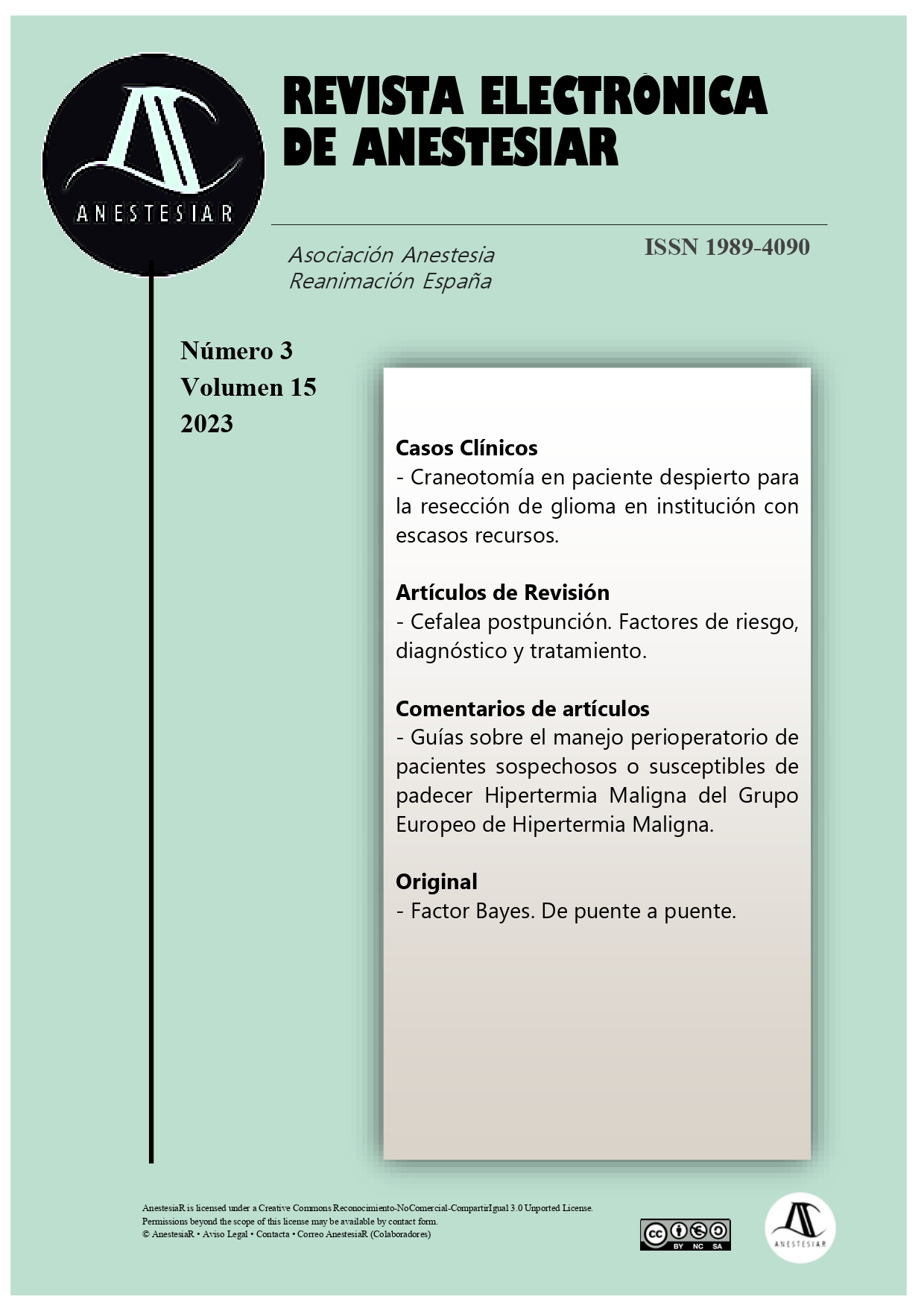Consensus guidelines on perioperative management of malignant hyperthermia suspected or susceptible patients from the European Malignant Hyperthermia Group
DOI:
https://doi.org/10.30445/rear.v15i3.1107Keywords:
malignant hyperthermia, activated charcoal filter, , anaesthesia WorkstationAbstract
Malignant hyperthermia (MH) is a life-threatening condition in which genetically predisposed individuals develop a hypermetabolic reaction to inhalational anesthetics or succinylcholine. Due to the rarity of the disease and ethical limitations, there are no intervention trials to inform the optimal perioperative management of patients susceptible to MH. These guidelines aim to group the available knowledge on the perioperative management of patients susceptible to MH and the preparation of anesthesia machines. The guidelines were developed by members of the European Malignant Hyperthermia Group and are based on evaluation of the available literature and a formal consensus process. The most important recommendation is that susceptible patients should receive trigger-free anesthesia, prophylactic administration of dantrolene should be avoided, intraoperative and postoperative follow-up should not be affected by susceptibility to the condition, and patients may be anesthetized in an outpatient setting.
References
Osenberg H, Davis M, James D, Pollock N, Stowell K. Malignanthyperthermia.Orphanet Journal of Rare Diseases. 2007;2: 21
Gupta PK, Hopkins PM. Diagnosis and management of malignant hyperthermia. British Journal of AnaesthesiaEducation. 2017;17: 249–54
Britt BA, Kalow W. Malignant hyperthermia: a statistical review.Canadian Anaesthetists Society Journal. 1970;17: 293–315
Hopkins PM. Malignant hyperthermia: pharmacology of triggering. Br J Anaesth 2011; 107: 48-56
Wappler F. S1-leitlinie maligne hyperthermie: update 2018 [S1 guidelines on malignant hyperthermia: update 2018].
Anaesthesist 2018; 67: 529-32
Hopkins PM, Rüffert H, Snoeck MM, et al. The European Malignant Hyperthermia Group guidelines for the investigation of malignant hyperthermia susceptibility. Br J Anaesth 2015; 115: 531-9
Dlamini N, Voermans NC, Lillis S, et al. Mutations in RYR1 are a common cause of exertional myalgia and rhabdomyolysis. Neuromuscul Disord 2013; 23: 540-8
Hackl W, Mauritz W, Winkler M, Sporn P, Steinbereithner K. Anaesthesia in malignant hyperthermia susceptible patients without dantrolene prophylaxis: a report of 30 cases. Acta Anaesthesiol Scand 1990; 34: 534-7
Litman RS, Smith VI, Larach MG, et al. Consensus statement of the Malignant Hyperthermia Association of the United States on unresolved clinical questions concerning the management of patients with malignant hyperthermia. Anesth Analg 2019; 128: 652-9
Heiderich S, Thoben C, Dennhardt N, et al. Low anaesthetic waste gas concentrations in postanaesthesia care unit: a prospective observational study. Eur J Anaesthesiol 2018; 35: 534-8
Litman RS, Joshi GP. Malignant hyperthermia in the ambulatory surgery center: how should we prepare? Anesthesiology 2014; 120: 1306-8
Targ AG, Yasuda N, Eger EI. Solubility of I-653, sevoflurane, isoflurane, and halothane in plastics and rubber composing a conventional anesthetic circuit. Anesth Analg 1989; 69: 218-25
Kim TW, Nemergut ME. Preparation of modern anesthesia workstations for malignant hyperthermia susceptible patients: a review of past and present practice. Anesthesiology 2011; 114: 205-12
Reber A, Schumacher P, Urwyler A. Effects of three different types of management on the elimination kinetics of volatile anaesthetics. Implications for malignant hyperthermia treatment. Anaesthesia 1993; 48: 862-5
Petroz GC, Lerman J. Preparation of the Siemens KION anesthetic machine for patients susceptible to malignant hyperthermia. Anesthesiology 2002; 96: 941-6
Dynasthetics. Prepare any anesthesia machine for susceptible patients in less than 90 seconds. Available from: https://www.dynasthetics.com; Accessed 05 March 2022
Sabouri AS, Lerman J, Heard C. Effects of fresh gas flow, tidal volume, and charcoal filters on the washout of sevoflurane from the Datex Ohmeda (GE) Aisys, Aestiva/5, and Excel 210 SE Anesthesia Workstations. Can J Anaesth 2014; 61: 935-42
Bilmen JG, Gillies RI. Clarifying the role of activated charcoal filters in preparing an anaesthetic workstation for malignant hyperthermia susceptible patients. Anaesth Intensive Care 2014; 42: 51-8
Downloads
Published
Versions
- 2023-04-26 (2)
- 2023-04-26 (1)
How to Cite
Issue
Section
License
Copyright (c) 2023 Revista Electrónica AnestesiaR

This work is licensed under a Creative Commons Attribution-ShareAlike 4.0 International License.
 Envío y derechos de autor
Envío y derechos de autor


 Revista Electrónica AnestesiaR by
Revista Electrónica AnestesiaR by 